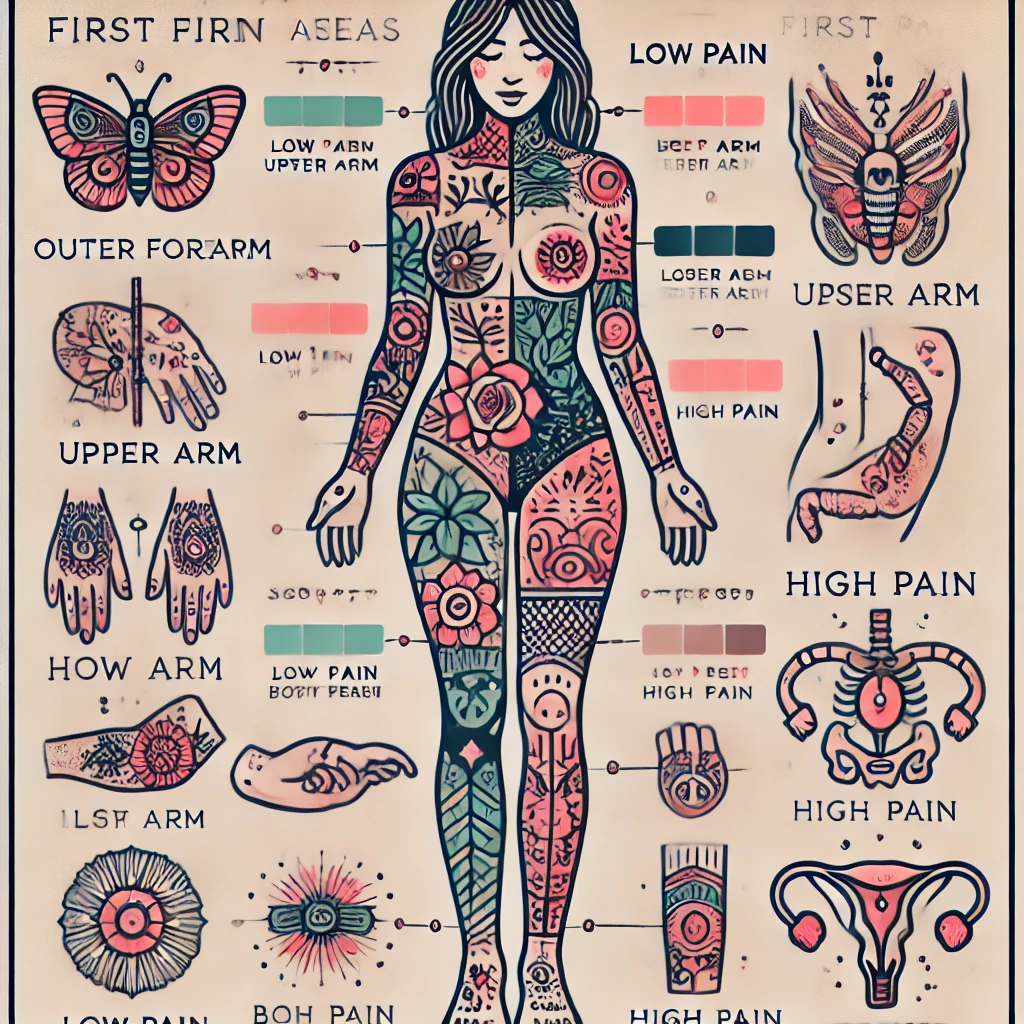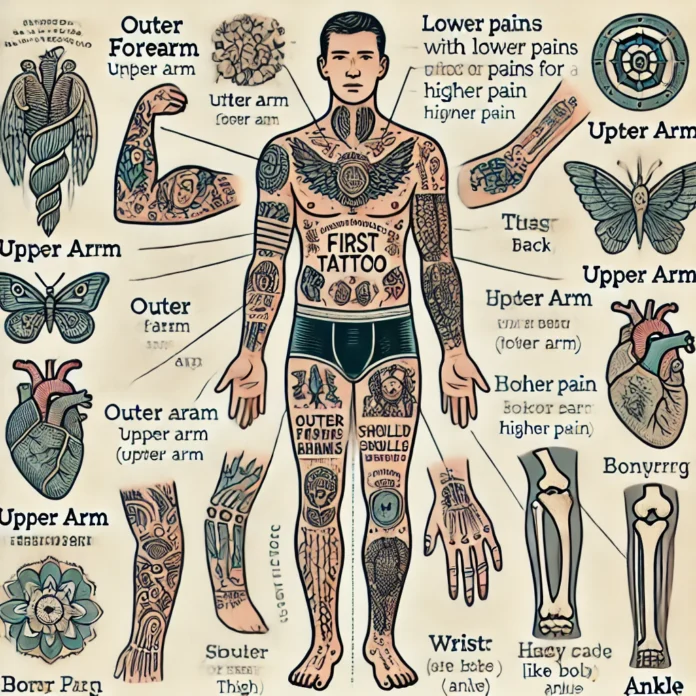Choosing the right placement for your first tattoo is a crucial step, as it can significantly affect both your overall experience and the visibility of the design. Your inaugural ink should be a balance of comfort and style, and the location you pick will play a key role in the entire process. For starters, areas like the outer forearm, thigh, or shoulder blade are excellent options. These spots not only provide ample muscle and fat to help mitigate discomfort, but they’re also versatile when it comes to showing off your new art.
If visibility is a key factor, consider ideal spots like the upper arm or back. These areas allow your tattoo to be easy to show off yet simple to conceal when necessary. On the other hand, if you’re aiming for a more discreet option, areas typically covered by clothing, such as the rib cage or ankle, may better suit your needs. Keep in mind that the rib cage can be an especially painful option, so it’s wise to assess your pain tolerance and consult with a professional tattoo artist. Their insights into the size, detail, and design of your tattoo will help you make a choice that aligns with your lifestyle and environment.
Understanding Tattoo Placement
When deciding on your first tattoo, it’s important to think about how the location can affect pain levels and visibility. The amount of discomfort you’ll experience depends on where you place the tattoo on your body, and some areas are naturally more conspicuous than others.
The pain levels vary based on nerve concentration and proximity to bone. For example, areas with fewer nerve endings, such as the outer thigh, are less painful and more sensitive to pressure. However, areas directly over bone—like the ankle or wrist—tend to cause more discomfort. If you’re unsure, choosing a spot that aligns with your pain tolerance is key.
For lower-pain areas, consider options like the outer arm, upper thigh, or calves, as these spots are great for a first tattoo. Conversely, high-pain areas such as the rib cage, ankles, and fingers should be approached with caution or avoided altogether for your first experience.
Best Spots For Your First Tattoo
When considering your first tattoo, it’s essential to choose a location on your body that best suits both your personal style and pain tolerance. Some areas, like the ones commonly picked, stand out for their visibility and their ability to age gracefully with the design over time.

Your arms are especially versatile, acting as a natural canvas for tattoos. They’re perfect for showcasing large designs, while also accommodating smaller, more discreet tattoos. These options make them an ideal choice for anyone looking for a balance of creativity and practicality in their first tattoo.
- Inner Forearm: A low-pain area that’s easy to show off or cover up.
- Outer Forearm: Highly visible, ideal for long and narrow designs.
- Upper Arm: Offers plenty of space, perfect for wrap-around tattoos like bands.
For Larger Tattoos
- Back and Shoulders:
- Shoulder Blades: Great for symmetrical designs or smaller individual tattoos.
- Full Back: A massive area for intricate and large-scale pieces.
- Upper Back: Works well for horizontal designs that can be concealed with clothing.
For Intimate or Private Tattoos
- Thigh: Perfect for larger, detailed designs in a low-pain area.
- Calves: Suitable for vertical or wrap-around artwork.
- Hip/Butt: Private locations with a flat and discrete surface.
Considering Your First Tattoo Size and Design
When you decide to get a tattoo, it’s important to consider the size and design, as these crucial factors can significantly influence how the tattoo will look on your skin. For those who prefer a minimalistic style or are concerned about the intensity of the tattooing experience, small tattoos are an excellent choice. These tiny designs often feature intricate detailing, which requires a skilled artist to achieve clarity and precision. Choose a location where fine lines won’t spread over time, such as the wrist, ankles, or behind the ear.
For larger tattoos, the scale of the design should harmonize with your body’s contours. Larger designs are ideal for broader areas like the back or thigh, where they can naturally flow with the muscle structure to create a cohesive and striking look.
Special Considerations for Specific Body Parts
When choosing your tattoo placement, it’s essential to consider the distinct characteristics of different body parts. Tattooing on areas with more bone or sensitive spots will feel very different compared to fleshier parts, and the visibility will also depend on the location.
Getting a tattoo over bone, such as the rib cage, sternum, or spine, can be more painful due to the lack of cushioning flesh. The needle will feel more acutely, and thin areas like the hand or fingers can also be challenging for beginners. Finger tattoos are especially tricky because of their high movement and frequent exposure to substances, which can lead to quicker fading. Similarly, the feet are another sensitive spot, as the skin here regenerates quickly, potentially causing tattoos to blur or fade sooner.
For nerve-rich areas like the neck, the tattooing process can be particularly sensitive. It’s important to consider your pain tolerance and the longevity of the tattoo when selecting these spots.
Conclusion
Choosing the right tattoo placement is as important as selecting the design itself. It’s vital to consider factors like pain tolerance, visibility, and the unique characteristics of different body parts. Whether you prefer a low-pain area like the outer forearm or are ready to brave sensitive spots like the rib cage or fingers, your decision should align with your personal style, lifestyle, and long-term goals for the tattoo. Consulting a skilled tattoo artist can also provide valuable insights to ensure your tattoo not only looks great but ages beautifully. Your first tattoo is a reflection of your individuality, so take the time to make an informed and thoughtful choice.
FAQs
Where should your first tattoo be?
Your first tattoo should be on a low-pain area like the outer forearm, upper arm, or calves for a more comfortable experience.
Where is the best spot to put a tattoo?
The best spot depends on your pain tolerance and visibility preferences. Common spots include the inner forearm, shoulder, and upper back.
What is the rule for tattoo placement?
The rule is to choose a location that suits your pain tolerance, style, and lifestyle, while considering factors like visibility and skin sensitivity.
Where is the safest place to get a tattoo?
Safer places are areas with fleshier skin, like the outer forearm or upper arm, as they tend to have lower pain levels and reduce the risk of complications.
